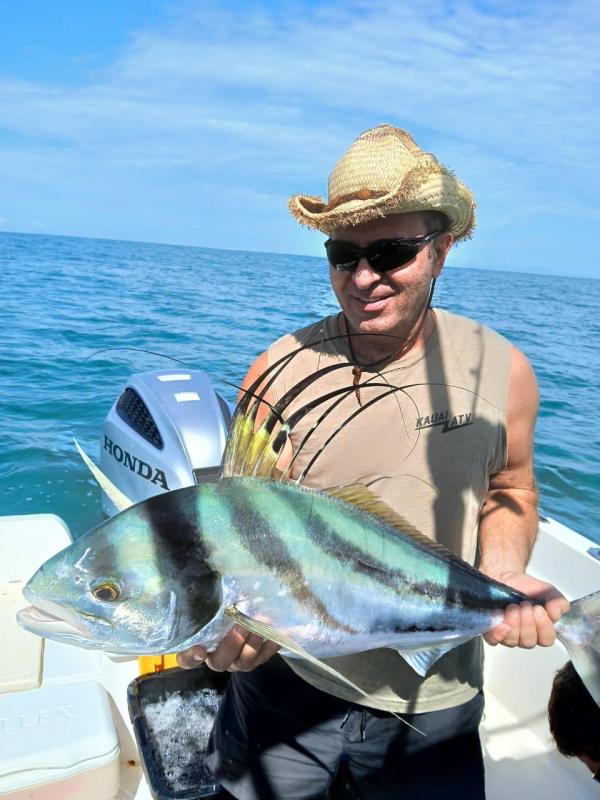A Guide to Fly Fishing in Costa Rica’s Waters

Fly fishing in Costa Rica offers an exciting twist on traditional fishing, presenting unique challenges, especially when targeting large species like marlin and sailfish. This guide will walk you through essential gear, techniques, prime locations, and sustainable practices to make your fly-fishing adventure memorable.
Choosing the Right Gear
When fly fishing for big game in Costa Rica, gear selection is crucial. Unlike typical freshwater fly fishing, the tackle required here is robust, designed to handle the immense power and speed of ocean fish. Here are key considerations for your setup:
Flies: Large, colorful popper flies are essential for attracting billfish. These mimic the movement of injured prey, which billfish can’t resist. Heavy-duty flies are often customized with bright colors and patterns to increase their visibility in open water.
Rod and Reel: Heavy-duty rods, generally 12-weight or higher, are recommended to withstand the pressure of large saltwater species. Fly reels with high drag capabilities and sturdy construction are necessary for long runs and tough fights. Costa Rica Fishing Experts often recommend choosing reels with a minimum of 300 yards of backing to handle strong, lengthy runs from powerful fish.
Tippet and Leader: Using a 20-pound-test tippet is standard when fly fishing for billfish. Strong leaders with shock tippets are also necessary to protect the line from the sharp bills of marlin and sailfish, which can easily cut through lighter gear.
Drag Setting: Setting the drag on your reel is another essential aspect, as it allows for balanced tension during a fish’s powerful run. Experienced anglers often adjust drag throughout the battle, starting with a lighter setting and increasing it as the fish tires.
The right gear will provide you with a more successful and enjoyable fly-fishing experience in Costa Rica, ensuring you can handle whatever the ocean throws at you.
Casting Techniques for Fly Fishing Success
Fly fishing for big saltwater species requires a different set of casting techniques compared to freshwater fly fishing. These fish are often moving quickly, so accuracy and timing are paramount.
Preparing for the Cast: Before casting, it’s crucial to anticipate where the fish will be. When targeting moving fish like sailfish, wait until the captain positions the boat alongside the fish. This gives you a clean casting lane, maximizing visibility and keeping your fly within the fish’s line of sight.
Backcasting: To effectively reach the target fish, a strong backcast is essential. In saltwater fly fishing, backcasts are more forceful than those used in freshwater environments. Aim for tight, controlled loops to avoid tangling and achieve distance.
Hook Set: Once the fish strikes, setting the hook involves a quick but firm strip-set rather than the traditional rod lift. This technique embeds the hook securely in the fish’s mouth and prevents it from easily escaping. Costa Rica Fishing Experts emphasize the importance of timing here, as a delayed set can lead to missed opportunities.
With practice, these techniques will help anglers develop the skills to target large, fast-moving fish with precision and confidence.
Best Locations for Fly Fishing in Costa Rica
The key to a successful fly-fishing trip in Costa Rica is choosing the right location. Some areas offer better conditions for casting and provide higher concentrations of target species. Below are the top spots recommended by Costa Rica Fishing Experts:
Los Sueños: Known as the sportfishing capital of Costa Rica, Los Sueños provides abundant populations of sailfish and marlin, ideal for fly fishing. The calm offshore waters allow for clear sightlines, making it easier to spot and cast toward these large fish. Sailfish are particularly active here between December and April, aligning perfectly with fly-fishing pursuits.
Quepos: Located further south, Quepos is another prime fly-fishing destination, known for high numbers of sailfish and occasional marlin during peak seasons. The waters near Quepos are known for their clean and open casting lanes, which increase visibility and make it easier for fish to spot the fly. Many anglers visiting Quepos take advantage of local charters that specialize in fly-fishing techniques.
Gulf of Papagayo: The Gulf of Papagayo in the northwestern part of Costa Rica is popular for inshore fly fishing. Here, you’ll find roosterfish, snapper, and other inshore species that are exciting targets for fly anglers. These fish frequent the rocky points and estuaries, giving anglers the chance to test their skills in diverse environments.
Tamarindo: Tamarindo is a year-round fly-fishing hotspot known for its laid-back environment and great fly-fishing charters that cater to all skill levels. This area is popular for both inshore and offshore fly fishing, with species like mahi-mahi and tuna frequently caught on the fly.
Drake Bay: Located on the Osa Peninsula, Drake Bay is a remote but rewarding destination for those looking for both diversity and a true wilderness experience. Here, anglers can target yellowfin tuna and wahoo offshore or roosterfish and snapper inshore.
Each of these locations offers unique opportunities for fly fishing, whether you’re interested in targeting sailfish and marlin offshore or roosterfish closer to shore. Costa Rica’s variety of fly-fishing spots ensures there’s something for everyone, from beginners to experienced anglers.
Conservation Practices in Costa Rica Fly Fishing
Costa Rica places a strong emphasis on sustainability and marine conservation, and fly fishing aligns closely with these values. Here’s a look at how fly fishing supports Costa Rica’s conservation goals:
Catch-and-Release: Fly fishing is commonly practiced as a catch-and-release sport, reducing the impact on local fish populations. Releasing fish, especially large game fish like sailfish and marlin, helps to maintain sustainable numbers, allowing future generations of anglers to experience the thrill of catching these species.
Reduced Impact: Fly fishing uses single hooks rather than multiple-hook lures, reducing the chances of injury to the fish. Since anglers target specific species visually, there’s also a lower bycatch rate than in other forms of fishing. Costa Rica Fishing Experts advocate fly fishing as an eco-friendly alternative that supports local marine ecosystems.
Minimizing Marine Litter: Fly anglers often use biodegradable materials for flies and other tackle components, further reducing the ecological footprint of their fishing excursions. This aligns with Costa Rica’s commitment to sustainable tourism and marine health, ensuring that the waters remain clean and thriving.
Supporting Local Conservation Efforts: Many fly-fishing charters in Costa Rica actively participate in local conservation programs, contributing to research and efforts that protect marine life. By choosing these responsible charters, anglers directly support the ongoing efforts to conserve Costa Rica’s natural beauty and biodiversity.
Practical Tips for Fly Fishing Success in Costa Rica
To make the most of your fly-fishing adventure, consider these additional tips:
Timing: Fly fishing is best during Costa Rica’s dry season (December to April), especially if targeting sailfish and marlin. This season offers calm seas and clearer waters, which enhance visibility and ease of casting.
Charter Selection: Choose a charter specializing in fly fishing, as these guides will have extensive knowledge of local fly-fishing techniques, locations, and the necessary gear. Costa Rica Fishing Experts frequently work with these charters to provide anglers with the best experience.
Weather Preparation: Costa Rica’s tropical climate can bring rain and strong sun, even in the dry season. Packing sun protection and lightweight rain gear will ensure that you’re comfortable on the water, no matter the conditions.
Practice Casting: Before heading out, practice casting at different distances to build precision and stamina. The repetitive motions required for saltwater fly fishing can be physically demanding, so building muscle memory is beneficial.
Embrace the Challenge of Fly Fishing in Costa Rica
Fly fishing in Costa Rica offers a thrilling blend of skill, technique, and conservation-minded practices. From the powerful runs of billfish to the beauty of casting in pristine waters, fly fishing provides a rewarding experience that brings anglers closer to Costa Rica’s vibrant marine life.
Whether you’re an experienced angler or new to the sport, Costa Rica’s fly-fishing opportunities, abundant fish species, and commitment to conservation make it one of the best destinations for a sustainable, action-packed fishing adventure.









Comments